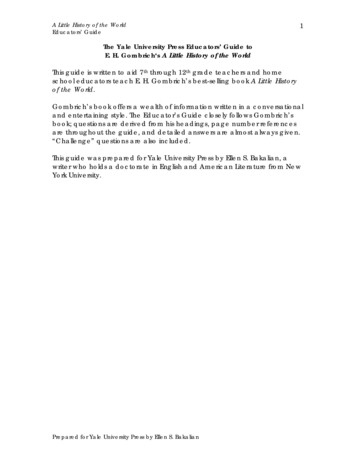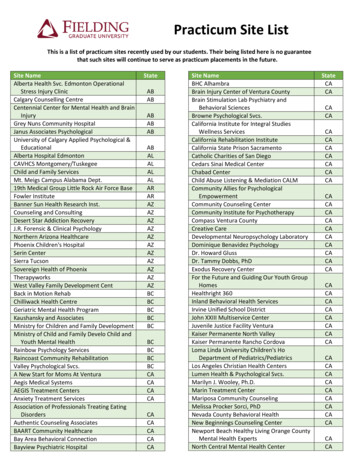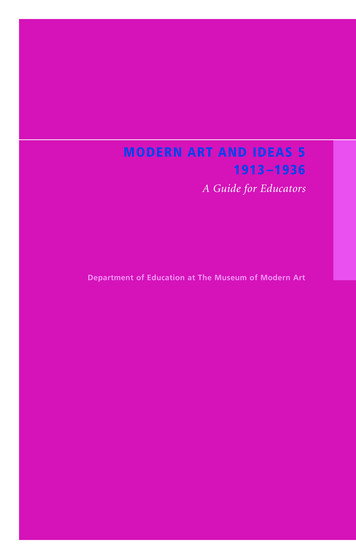
Transcription
A Little History of the WorldEducators’ Guide1The Yale University Press Educators’ Guide toE. H. Gombrich‘s A Little History of the WorldThis guide is written to aid 7th through 12th grade teachers and homeschool educators teach E. H. Gombrich’s best-selling book A Little Historyof the World.Gombrich’s book offers a wealth of information written in a conversationaland entertaining style. The Educator’s Guide closely follows Gombrich’sbook; questions are derived from his headings, page number referencesare throughout the guide, and detailed answers are almost always given.“Challenge” questions are also included.This guide was prepared for Yale University Press by Ellen S. Bakalian, awriter who holds a doctorate in English and American Literature from NewYork University.Prepared for Yale University Press by Ellen S. Bakalian
A Little History of the WorldEducators’ Guide2Chapter One: Once Upon a TimeWhat is history? What do you think?Create a list or write an essay. Is history the past? A memory? A collectionof memories? Facts, and facts alone?Chapter Two: The Greatest Inventors of All Time1. How can we explain the deep past, before there were humans onearth? To explain “prehistory,” as it is called, we rely upon artifacts.2. Define artifact. Give a few examples of prehistory artifacts.Fossils, tools, bones.3. What is the Heidelberg jaw? Where was it found?The Heidelberg jaw is a powerful jaw of a man that is thought to bebetween 400,000 and 650,000 years old. It is a chinless jaw, broad,massive, and apelike; the teeth are proportionately too small for so largea jaw. It was found in 1907 near Heidelberg, ticle-9326043/Heidelbergjaw)4. What is the name we give to early man? Why do we give him thatname? The earliest man was the Neanderthals, so called because ahuman skull was found near the Neander Valley, in Germany.5. Why is the Stone Age called the “stone” age?Archeologists have uncovered stone tools, and so this time is called the“Stone Age.” The earliest tools were probably just sticks and stones, butsoon the stones were shaped and sharpened. (Gombrich 7)6. Prehistoric man is known as “cavemen,” although they may not haveactually lived in caves. These cavemen invented stone tools, but whatelse?Cavemen from the Stone Age invented talking, and pictures, many ofwhich can still be seen today, scratched and painted on the walls ofcaves.7. How did the Bronze Age gets it name?It was during the Bronze Age that man discovered metals, little by little,and learned how to melt copper and tin together to make bronze.Helmets, swords, axes and jewelry was made during the Bronze Age.Prepared for Yale University Press by Ellen S. Bakalian
A Little History of the WorldEducators’ Guide3Chapter Three: The Land by the NileTo say “history” and not “prehistory” means that we can give something aplace and date.History, with a date and a place, began with King Menes, who ruled overEgypt in 3100 BC.1. What were kings of Egypt called?They were called pharaohs, and were immensely powerful. The PharaohMenes lived in a great stone palace with massive pillars.2. Find Egypt on a map. Locate the River Nile and trace its route. Todaythere is a manmade dam on the River Nile. What is it called? Researchthe dam and how it changed Egypt.3. What is the type of writing that the Egyptians created?The Egyptians developed an elaborate way of writing, using pictures,called hieroglyphics. Their words and pictures are still seen today on thewalls of the elaborate tombs they created.4. Which Pharaoh built the Great Pyramid?Pharaoh Cheops, in 2500 BC.5. How did the Egyptians build the temples and the pyramids?Egyptian workers built these massive buildings, stone by stone. They hadno machines; perhaps some rollers and pulleys at the most.6. Describe one or two Egyptian gods.The Egyptians believed in many gods. The god Osiris and his consort Isiswere the main gods, along with the sun god, Amon. TheKingdom of the Dead was ruled by was Anubis, always represented by ajackal’s head. Each pharaoh believed he was a son of the sun god, whichexplains why the Egyptians feared the Pharaoh, and obeyed all hiscommands.7. What is an obelisk? Are there any Obelisks still standing today? Anylocated near you? Where?Obelisks were tall pillars, cut from single piece of granite (means “littlespear” in Greek). Several cities around the world have Egyptian obelisksthat were “gifts” from archeologists. There are several standing today -one in Central Park, in NYC, and one in Rome, Italy.Prepared for Yale University Press by Ellen S. Bakalian
A Little History of the WorldEducators’ Guide48. Challenge: Research the recent controversies surrounding ancient artthat is ‘stolen’ from one country and put on display in other country’smuseum. Did this happen with Egyptian art?9. Why is the Sphinx in the shape of a cat?Animals are sacred to the Egyptians, especially the cat. The Sphinx isabout 5000 years old.10. Explain the Egyptian’s burial rites.The Egyptians believed that man’s soul left body when dead, yet for “thesoul continued to need the body, and it would suffer if it crumbled to dust.To preserve the body, they rubbed it with ointments and the juices ofcertain plants and bandaged it with long strips of cloth, so that it wouldn’tdecay” (Gombrich 12). The mummy was placed in wood coffin, and thenwithin a stone coffin which was buried not in the earth, but in a tomb thatwas chiseled out of the rock. Powerful pharaohs had huge tombs, for thetomb was intended to be a dwelling for the soul when it returned to visit itsbody. Food, furniture and even clothes were placed in the tombs. Thewalls are exquisitely painted, depicting scenes from the departedperson’s life. His “portrait was there too; to make sure that when his soulcame on a visit it wouldn’t go to the wrong tomb” (Gombrich 12 – 13).11. Where can you see mummies and Egyptian art?In Cairo, at the Egyptian Museum; the Metropolitan Museum of Art in NewYork City; the British Museum in London.12. How do we know so much about Egyptian life?Gombrich writes: “Thanks to the great stone statues, and the wonderfullybright and vivid wall paintings, we have a very good idea of what life inancient Egypt was like: how they used great nets to catch ducks on theNile, how they fished with long spears, how they threshed grain, madeshoes and clothes, blew glass. Pictures survive depicting girls playingcatch, or playing music on flutes, and soldiers going off to war, orreturning with loot and foreign captives, such as black Africans”(Gombrich 13).13. What is the Rosetta Stone?The Rosetta Stone is what enabled archeologists to decipher hieroglyphs.In 1799 the French discovered the huge stone artifact, weighing over 1000pounds. Written on the Rosetta Stone are the same words written in threedifferent scripts: ancient Greek, hieroglyphs and another Egyptian script.It was still a tremendous puzzle, and great scholars devoted their lives to it”(Gombrich 14). The Rosetta Stone is on display at the British Museum, inLondon.Prepared for Yale University Press by Ellen S. Bakalian
A Little History of the WorldEducators’ Guide514. Challenge: Research the Rosetta Stone. Who found it, and where? Howdid it end up in the British Museum? How long did it take for scholars todecipher it?15. What is papyrus?Papyrus is made from a reed that grows along the Nile River. Egyptianswrote on long strips of papyrus. The word “papyrus” is Greek, from whichour name for paper comes.16. Which Empire lasted the longest? Egyptian or Roman?The Egyptian empire lasted longer than “any empire the world has everknown: nearly three thousand years.” Gombrich 15)17. What is the Pharaoh Akhenaton known for?Akhenaton did not like the Egyptian religion, and so he shut down thetemples, and even changed the style of painting. As soon as he died, thepeople reverted to the older ways.Chapter Four: Sunday, Monday1. The Egyptians were not the only ancient peoples who we can nowcredit for things, but they are the most well-known. Another ancientpeople lived in Mesopotamia, which is a Greek word that means landbetween the rivers. Where was Mesopotamia located? What country isthere today?Mesopotamia is a country that lies between the rivers Tigris and theEuphrates, in the country we know today as Iraq. The Tigris and theEuphrates rivers join together and flow out into the Persian Gulf.2. Mesopotamia was located in a vast plain, crossed by two rivers, a landof heat and swamp and sudden floods. Here and there tall hills rise out ofthe plain. Are these hills just regular hills?No, the hills in Mesopotamia are really “ruined towns, palaces andtemples. But unlike Egypt’s stone temples and pyramids, they were builtwith sun-baked bricks which cracked and crumbled over time, andeventually collapsed into great mounds of rubble” (Gombrich 17-18.)3. Name one or two cities that were in Mesopotamia.Babylon, once the greatest city on earth city, was the capital of theBabylonians. The nearby city of Nineveh was the capital of the Assyrians.4. What empires existed in Mesopotamia?Prepared for Yale University Press by Ellen S. Bakalian
A Little History of the WorldEducators’ Guide6The Sumerians, the Babylonians and the Assyrians. Unlike Egypt,Mesopotamia was rarely ruled by just one king.5. What were the Sumerians like?The Sumerians created a culture, with towns, tradesmen, noblemen andkings, temples and priests, administrators and artists – people with writingand technical skills. For many years the Egyptians were given credit for allthese things, but the Sumerians deserve credit for this. (Gombrich 18)6. What is important about the city of Ur, in Mesopotamia?The city of Ur, a Sumerian town, is in one of the mounds, and it is the placewhere Abraham was born, according to the Bible. Some of the tombs inUr date from the same time as King Cheops’ Great Pyramid in Egypt, 2500BC.7. What was discovered in the tombs of Ur?The tombs in Ur contained gold helmets and vessels and daggers set withprecious stones. Some of these things are in the British Museum today.(Gombrich 18)8. What is cuneiform?Cuneiform is the Sumerian’s type of script. It means “wedge-shaped,”and is made up of single strokes ending in a small triangle or wedge. Theancient Sumerians wrote on baked clay tablets, not papyrus. Many ofthese clay tablets were discovered, and some were merchant tablets,letting us know that the ancient Sumerians, Babylonians and Assyrianswere tradesmen. (Gombrich 19)9. Who is King Hammurabi, and what is the Code of Hammurabi?The Code of Hammurabi is a rule book created by the Babylonian KingHammurabi who lived around 1700 BC.10. What did the Babylonians and Assyrians worship?The Babylonians and Assyrians worshipped the sun, moon and the stars.They observed and recorded the movement of the stars and what theysaw in the sky. They gave star shapes names, and thought planetssymbolized things, like war (Mars) and love (Venus).11. How did their observations of the planets carry forward into somethingwe use every day?To each of the 5 planets the Babylonians and Assyrians dedicated a day,and with the sun and moon that made 7 days. This was the origin of ourseven-day week. In English we still say Satur (Saturn) –day, Sun-day, andMon (moon) –day.Prepared for Yale University Press by Ellen S. Bakalian
A Little History of the WorldEducators’ Guide712. Challenge: Gombrich writes that “in other languages such as Frenchor Italian -- most of the days of the week still belong to the planets that theBabylonians first named” (Gombrich 20). What are the days of the weekin Spanish? In French? In Italian? Do these words correspond to a planet,such as Mars?13. Who was Nebuchadnezzar? Why is he remembered?The last great Babylonian king was Nebuchadnezzar who lived around600 BC. He is remembered for his feats of war. He fought against Egyptand brought a vast number of foreign captives home to Babylon asslaves. His truly greatest deeds however are the canals and water cisternshe had dug in order to retain the water and irrigate the land, so that itbecame rich and fertile. Only when those canals became blocked withsilt and the cisterns filled with mud did the land become what it is today:a desert wasteland and marshy plain with the occasional mound.(Gombrich 21)Chapter Five: The One and Only God1. Why does Gombrich say that the Palestinians, the Jews, were“something special, that they didn’t just become a part of history, theymade history” (Gombrich 24).Because of their religion. Thousands of other small tribes were conqueredand ruled by the Egyptians and then the Babylonians, but unlike othertribes, the Jewish people remained true to their religion. They prayed toone god only -- they even went so far to insist that he was only god therewas. (Gombrich 25)2. What is the story of the Tower of Babel? Or what does it mean whenpeople use the word “babel”?The Babylonians built gigantic towers so they could be nearer the sun,moon, and stars which they studied. They tried to build a tower thatwould reach up to heaven, but God became angry at their pride, and tostop them from building any higher, he made them all speak differentlanguages so that they could no longer understand each other – itsounded just like babel – the Tower of Babel.3. Who was King Solomon?King Solomon “was a wise and just king who ruled soon after 1000 BC,which was about 700 years after King Hammurabi and 2,100 years afterKing Menes. He built the first Temple of Jerusalem.Prepared for Yale University Press by Ellen S. Bakalian
A Little History of the WorldEducators’ Guide84. What was located in the innermost part – the holiest part -- of KingSolomon’s Temple?In the innermost sanctum there was nothing -- no image at all, for theJews believed that no image of God “could or might be made.” This wasunusual at the time – think of the Egyptians hieroglyphics of gods – andtherefore the Jews were regarded differently. (Gombrich 27)5. To what event does the phrase “Babylonian captivity of the Jews” refer?After King Solomon’s reign, King Nebuchadnezzar, the Babylonian king,marched through the Jewish city of Jerusalem in 586 BC. He captured theJews, and took them back to Babylon as slaves. Remarkably for the Jews,the people who survived became even more devout. (Gombrich 27)The Jews were viewed differently by other people, for they worshipped agod that could not be seen, among other beliefs.Chapter 6: I Can Read1. Another ancient people were the Phoenicians. What are thePhoenicians famous for?The Phoenicians developed the twenty six simple letters that make up ouralphabet. “Simple” compared to the Egyptian hieroglyphs or thecuneiform script. The Phoenicians did a lot of writing -- not just songs andstories, but contracts and other business transactions -- for they weremerchants. They traveled far to do business, bartering and trading inevery land.2. Where did the Phoenicians live? Where did they do their trading?The Phoenicians lived near Jerusalem in bustling cities of Tyre and Sidonthat rivaled Babylon. The Phoenicians made their conquests by sailing tounknown shores, setting up trading posts and trading with the wild tribesthey met there. They would trade fur and precious stones in exchange forcooking pots and colored cloths. Their craftsmanship was knownthroughout the world.3. Many Phoenicians stayed in their trading posts on foreign shores andbuilt towns. Were they welcomed?Yes the Phoenicians were welcomed everywhere, in Africa, Spain and insouthern Italy, because they brought beautiful things with them to tradeand sell.4. Gombrich states that the Phoenicians did not feel cut off from theirhome and their families. Why?Prepared for Yale University Press by Ellen S. Bakalian
A Little History of the WorldEducators’ Guide9The Phoenicians could write to their relatives, using the “wonderfully simplescript they had invented, which we still use today” (Gombrich 30).Chapter 7: Heroes and their WeaponsHomer: Homer is a legendary ancient Greek poet, traditionally said to bethe author of the epic poems the Iliad and the Odyssey. The ancientGreeks generally believed that Homer was a historical individual, butmodern scholars are skeptical. (http://en.wikipedia.org/wiki/Homer).In 1868 a wealthy German business man named Schliemann decided tofind out if Homer’s stories had any historical reality. His archeologicaldiggings in and near Troy lend “material weight” to Homer’s Iliad andVergil’s Aeneid as reflecting historical events”(http://en.wikipedia.org/wiki/Heinrich Schliemann).1. What did Schliemann discover?Schliemann went to Greece, and dug for the cities mentioned in Homer.At Mycenae he discovered palaces and tombs of kings, armor andshields, just as the Homeric songs had described them. He found the cityof Troy, destroyed by fire, as Homer wrote. A ring was found, withEgyptian hieroglyphs, and it said the name of an Egyptian king,Akhenaton, the great reformer, who lived around 1400 BC. Schliemanndiscovered that most of what Homer wrote was true – “not in every detail,of course: the heroes named in the song were no more real than thegiants and witches in fairy tales. But the world that Homer describes – thedrinking cups, the weapons, the buildings and the ships, the princes whowere at the same time shepherds, and the heroes who were also searaiders – were not inventions” (Gombrich 33).2. Research the various ways today’s archeologists date objects. Visit amuseum and notice the dates on the ancient objects.3. Schliemann found vessels and daggers in Greece. Where were theseobjects created?It is now thought that the things Schliemann found in his excavations ofGreek cities – fine vessels and daggers decorated with hunting scenes,the golden shields and helmets, the jewelry and even the colorfulpaintings – were not invented there, but were made on the island ofCrete during the time of King Hammurabi (about 1795 – 1750 BC).(Gombrich 34)Prepared for Yale University Press by Ellen S. Bakalian
A Little History of the WorldEducators’ Guide104. Name some of the differences between Cretan and Egyptian art.The Egyptian pictures are very beautiful, but rather severe and stiff. TheCretan artists liked to catch people or animals in motion – “houndschasing wild boar, and people leaping over bulls – nothing was too hardfor them to paint.” The Greeks learned a great deal from the Cretanartists. (Gombrich 34)5. Throughout the book Gombrich tells us things like “when the Greekscame to Greece, they weren’t yet Greeks.” What does he mean by this?Gombrich is pointing out that tribes invaded the lands they were tooccupy; they weren’t yet a unified people. They spoke different dialectsand had different chieftains. In Greece, for example, the tribes wereDorians and Ionians. The city of Sparta, in the southernmost tip ofGreece, was settled by the Dorians, while the Ionians settled in Athens.Both Dorians and Ionians were great seafarers and they soon tookpossession of the many islands nearby. Eventually they were all Greeks.Chapter 8: An unequal Struggle1. Who were the Persians? Where did they live? What did they worship?Persians were small bands of mountain people long dominated byAssyrians and Babylonians. They worshipped light and the sun andbelieved it to be in a state of constant warfare with the dark, the darkpowers of evil.2. Who was Cyrus? What did he do?Cyrus was the ruler of the Persians around 538 BC. Against the odds, Cyrusand his army defeated the Babylonians thereby freeing all the slaves,which included Jews who returned to Jerusalem.3. What amazing feat did Cyrus’ son Cambyses do?Cyrus’ son King Cambyses marched on Egypt, and defeated theEgyptians. The Pharaoh was deposed, which effectively ended theEgyptian Empire -- after 3000 years of existence. Cambyses’ now rulednearly all the known world, but not Greece. (Gombrich 38)4. The vast Persian Empire was ruled by what king? How big were hislands? What did he want?Persian King Darius governed the Persian Empire which stretched fromEgypt to India. He built roads, and headed out towards the coast wherethe Ionian Greeks lived. He called himself King of Kings and wanted todestroy Athens and conquer Greece.Prepared for Yale University Press by Ellen S. Bakalian
A Little History of the WorldEducators’ Guide115. Why is the Battle of Marathon famous? Why is it called “marathon”?The Battle of Marathon, between the Greeks and the Persians, was foughtin 490 BC. The Persians dropped anchor at Marathon, a city not far fromAthens, and 70,000 Persians disembarked, ready to march. The Athenianswere outnumbered seven to one, but their leader, Miltiades, formed ranksin Marathon and startled the Persians, causing them to flee towardsAthens by sea. Miltiades knew it was a shorter distance to Athens overland, so he sent a runner to warn the Athenians. This is “the Marathon Run,after which we call our races. Famous, because the messenger ran so farand so fast that all he could do was deliver his message before he felldown dead” (Gombrich 39). Because of this Marathon-Runner, in 490 BC,Athens and all of Greece was saved.6. What happened at the pass called Thermopylae?The Persians attacked Greece by sea and by land. Spartans, fromnorthern Greece, allied themselves with the Athenians, and tried to blockthe Persian advance in a narrow pass called Thermopylae. Although theywere outnumbered, the Spartans would not throw down their spears, asthe Persians requested. “The Persians quickly surrounded the Spartansand killed them all – 300 Spartans and 700 Greeks. Not one of them triedto run away, for that was their law” (Gombrich 41).7. Who were the Spartans? What is the definition of the word “Spartan”?Sparta and Athens were Greece’s most important cities. The Spartanswere Dorians, who arrived in Greece around 1100 BC, and enslaved thelocal inhabitants. Spartans prided themselves on being ready for rebellionand “their aim in life was to be fighting fit, ready to crush any uprising bytheir slaves.” From young ages, Spartan children were taught to endurepain, hunger and cold, and to be denied all pleasures. Today we use theword “Spartan” to describe a harsh upbringing. (Gombrich 46)8. The Greeks were always outnumbered against the Persians, yet theypersevered. What made the Greeks different than other peoples?The Greeks were constantly trying new things – they did not cling to thepast. Gombrich writes: This “explains why, during the hundred years thatfollowed the Persian wars, more went on in the minds of the people of thelittle city of Athens than in a thousand years in all the great empires of theEast. The ideas, the painting, sculpture and architecture, the plays andpoetry, the inventions and experiments, the discussions and argumentswhich the young brought to the marketplaces and the old to their councilchambers still continue to concern us today. It is strange that it should beso, and yet it’s true.” (Gombrich 43)Prepared for Yale University Press by Ellen S. Bakalian
A Little History of the WorldEducators’ Guide12Chapter 9: Two Small Cities in One Small LandGreece was not yet a unified country – the Dorians occupied the south,the Ionians and the Aeolians were in the north. Each city was a kingdomin itself, and the kingdoms “spent all their time bickering and exchanginginsults.” (Gombrich 45)However, the Greeks were united by their religion and their sport, whichwere closely connected. The Greeks worshipped the gods, and to honorthem, they would have great sporting events.1. What god did the Greeks honor at their Olympic games? What gameswere held?In honor of Zeus, the Father of the Gods, there was a sporting contest“every four years in which all Greeks -- Dorians, Ionians, Spartans andAthenians - came to Athens to show how well they could run, throw thediscus and the javelin, fight hand to hand and race chariots” (Gombrich45).2. What prizes did the victors win?To be victorious at Olympia was “the greatest honor in a man’s life. Theprize was no more than a simple garland made from sprigs of wild olive,but what fame for the winners: the greatest poets sang their praises; thegreatest sculptors carved their statues to stand for ever in Olympia.Victory statues can still be seen today” (Gombrich 45).3. What happened at the Temple at Delphi? What was the shrine called?A temple was built in Delphi in honor of Apollo, the sun god, and it wascalled the Delphic Oracle. “In the temple was a fissure from which avapor issued. If anyone inhaled it, it literally clouded her mind, as if shewas drunk or delirious, and nothing she said made sense. The verymeaninglessness of these utterances seemed deeply mysterious to theGreeks, who said that ‘the god himself speaks through a mortal mouth’.As the priestess sat over the fumes, other priests interpreted her babble asprediction of the future” (Gombrich 45 – 46).4. Greeks would make pilgrimages to the Delphi, to consult the godApollo. How accurate was the Delphic Oracle?The answer was so unclear and puzzling that the word “oracular” todaymeans “vague” or “enigmatic.” The answer could easily be interpretedin a variety of ways.Prepared for Yale University Press by Ellen S. Bakalian
A Little History of the WorldEducators’ Guide135. The Athenians had fewer reasons to be afraid of outsiders, but they livedby strict rules created by a leader named Draco. What does the word“draconian” mean today?Draconian is a word we use today to denote severity.6. Democracy is an idea that its roots in Greek cities. In 594 BC, King Solonintroduced new laws. (This is the same time as when Nebuchadnezzarruled.) What did Solon’s rules decree?Solon’s rules decreed that the people who lived in the city should decidetheir own affairs and own laws. The majority would decide to elect acouncil of experts to put those decisions into effect. This type ofgovernment is “democracy,” or ‘the rule of the people’ in Greek.7. Could anyone become a citizen, and vote with the majority?No, citizenship depended upon wealth and influence, and women andslaves were excluded.8. The word “politics” derives from Greek. What does it mean?‘Polis’ is Greek for city, and ‘politics,’ the affairs of the city. (Gombrich47)9. What did Athenians do with their rulers who showed signs of acting liketyrants?The Athenians banished any politician who acted like a tyrant; they didnot tolerate that behavior.10. Who was Pericles? What is his claim to fame?By 444BC, Pericles was Athens’ sole ruler. He was a wise and intelligentman. (Gombrich 48)11. Describe Pericles, for he was more than a warrior king.Pericles’ main concern was that Athens retains its power at sea, and thishe achieved through the alliances he made with Ionian cities, which paidAthens for its protection. Pericles was also interested in truth and beauty,and in what they called “reflecting” -- what we call philosophy.12. Challenge: What playwright wrote a play entitled “Pericles”? Readthe play and compare what you know about Pericles to the play’sdepiction of the man. William Shakespeare.13. Gombrich writes that the Athenians began to think about things in anew way, and they also saw things differently. What are the new ways inwhich they were thinking? What new style of art did the Athenian artistscreate?Prepared for Yale University Press by Ellen S. Bakalian
A Little History of the WorldEducators’ Guide14Philosophers and deep thinkers were gaining respect in Athens at this timeas people became interested in what was just and what was unjust,about how people should act, what was good and what was evil. Thesewere new thoughts for a new age. Greek artists created objects andstatues that looked natural. The sculptor Phidias created statues of godswith the same beauty and humanity as he did statues of man. Phidias didnot create mysterious images, like the Egyptians, but realistic ones. If youvisit the Acropolis in Athens, you can see the remains of the statues datingfrom the time of Pericles (444BC).14. Find a picture of the Acropolis and study it. What is noticeable aboutthe architecture – something that we might take for granted, but that theGreeks invented and perfected?The Acropolis is a beautiful marble building supported by what we call“Greek columns.” Greek columns are everywhere, but Gombrich assertsthat “none of them is as beautiful as the ones on the Acropolis where theywere used not for show and decoration but for the purpose for which theywere invented: as elegant supports for the roof” (Gombrich 49).15. Go online and research the extensive Greek and Roman artcollections in the following museums. Find out what other museum houseGreek art. Are images of some of their collections available online? National Archaeological Museum of AthensThe Acropolis Museum (at the Acropolis of Athens)Delphi Museum, GreeceBritish Museum, LondonMetropolitan Museum of Art, New YorkJ. Paul Getty Museum, Los AngelesThe Getty Villa in Malibu, CA16. The Athenians perfected the art of poetry, and they also created anew form of literature. What was it?The Athenians invented the theatre, which was also bound up by theirreligion, with festivals held in honor of the god Dionysus, also known asBacchus. On his feast day a performance could last all day. “We stillhave the plays which the Greeks performed, serious, grand plays knownas tragedies, or the witty lively plays known as comedies” (Gombrich 50).Chapter 10: The Enlightened One and his LandLike Mesopotamia, ancient civilizations were prevalent in India.Prepared for Yale University Press by Ellen S. Bakalian
A Little History of the WorldEducators’ Guide15Around 2500 BC, when the Sumerians were holding sway at Ur, there wasa mighty city in the valley of Indus (today’s Pakistan) called MohenjoDaro, with well-drained streets, canals and workshops.1. When was the city of Mohenjo Daro discovered?Its ruins were discovered in the 1920s, and until then, no one knew itexisted. We know nothing about the people who built Mohenjo Daro, butwe know
8. Challenge: Research the recent controversies surrounding ancient art that is ‘stolen’ from one country and put on display in other country’s museum. Did this happen with Egyptian art? 9. Why is the Sphinx in the shape of a cat? Animals are sacred to the Egyptians, es










